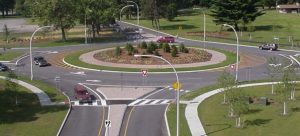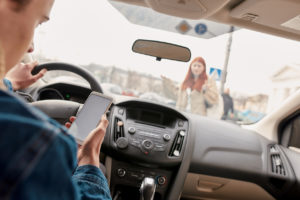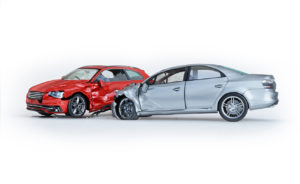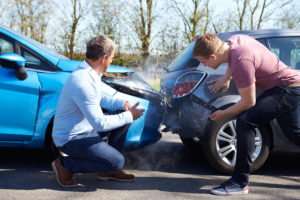Key Points:
- Sideswipe collisions are a daily occurrence on Atlanta’s congested roadways and interstates, and have the potential often producing catastrophic injuries.
- If you are involved in a side-impact accident, proving who was at fault is an essential step to building a strong legal claim for your damages, but it can also be a huge challenge because the facts are easily disputed in these types of collisions.
- The at-fault driver can be held responsible for all costs associated with the crash, including medical expenses, lost income, pain and suffering, or wrongful death.
Side-impact car accidents can happen for all sorts of reasons, from a moment of distraction to someone blatantly ignoring the rules of the road. And with Atlanta’s packed roads and highways, these crashes are sadly pretty common, leading to some serious injuries.
Ever been caught in one of these side-impact collisions? Figuring out who’s to blame is your first big step. Knowing who was careless (yep, the negligent driver) is key to seeing if you’ve got a solid case for your damages. But here’s the catch: pinning down who’s at fault can be tricky. Disputes over what really happened are all too common. If it turns out the other driver was at fault, they might have to cover everything — from your medical bills and lost wages to compensation for your pain and suffering, or even wrongful death.
What Exactly is Considered a Sideswipe Accident?
A sideswipe collision, a specific type of traffic accident, happens when the side of one vehicle makes contact with the side of another vehicle. This usually occurs when both vehicles are moving parallel to each other, often in the same direction. The nature of the impact varies; it can either result in significant damage to the vehicles involved due to the direct force of the collision or manifest as a more superficial, glancing contact. While a glancing blow might not cause substantial damage on its own, it can lead to more severe consequences by pushing the affected vehicle off its course. This deviation can force the vehicle into a secondary collision, potentially with another vehicle, a stationary object, or even off the road, leading to far more serious damage and risk to the occupants.
Different Scenarios and Types of Side Swipe Accidents
Side-swipe accidents can occur in a variety of scenarios, each with its own set of challenges and potential consequences. Here are different scenarios and types of side-swipe accidents:
Merging Lanes on Highways
One vehicle attempts to merge into a lane but misjudges the distance to an adjacent vehicle, causing a side-swipe.
Who is Likely At-Fault: The vehicle attempting to merge is likely at fault for misjudging the distance and causing a side-swipe.
Severity Potential: Moderate to High
How Common is This Type of Accident: Common. Merging and lane changes on highways are frequent sources of accidents due to high speeds and the complexity of merging safely with fast-moving traffic.
Georgia Traffic Law(s) Broken:
- O.C.G.A. § 40-6-123 (Failure to Use Turn Signals): Not signaling intentions when changing lanes.
- O.C.G.A. § 40-6-48 (Failure to Maintain Lane): Moving from a lane without ascertaining that such movement can be made safely.
Changing Lanes in Traffic
A driver fails to check their blind spot or signal before changing lanes, clipping the side of a car that was in their blind spot.
Who is Likely At-Fault: The driver who fails to check their blind spot or signal before changing lanes is typically considered at fault for clipping another vehicle.
Severity Potential: Low to Moderate
How Common is This Type of Accident: Very common. This is one of the most frequent causes of accidents, especially in urban and suburban areas, due to the constant need to adjust lanes in dense traffic.
Georgia Traffic Law(s) Broken: (Failure to Maintain Lane): Moving from a lane without ascertaining that such movement can be made safely.
Parallel Lane Drift
A distracted or fatigued driver unintentionally drifts into a neighboring lane, sideswiping another vehicle traveling in the same direction.
Who is Likely At-Fault: The distracted or fatigued driver who drifts into another lane is generally at fault for the side-swipe collision.
Severity Potential: Low to High
How Common is This Type of Accident: Moderately common. Distraction, fatigue, and impairment are often contributors to vehicles drifting out of their lanes, leading to potential sideswipe collisions.
Georgia Traffic Law(s) Broken: O.C.G.A. § 40-6-48 (Failure to Maintain Lane): Drifting out of a lane unintentionally, indicating a lack of vehicle control.
High-Speed Sideswipe
Occurs on highways or interstates where vehicles are traveling at high speeds, significantly increasing the risk of severe damage and injuries.
Who is Likely At-Fault: Fault can be complex to determine but often lies with the driver who made an unsafe lane change or failed to maintain proper lane discipline at high speeds.
Severity Potential: High
How Common is This Type of Accident: Less common but with a higher risk of severe outcomes. High-speed collisions, including sideswipes, tend to result in more significant injuries and damages.
Georgia Traffic Law(s) Broken:
- O.C.G.A. § 40-6-181 (Speeding): Exceeding the speed limit, contributing to the likelihood and severity of accidents.
- O.C.G.A. § 40-6-48 (Failure to Maintain Lane): Not keeping within the lane at high speeds.
Urban Traffic Sideswipe
In congested city traffic, a slight misjudgment or distraction leads to a vehicle sideswiping another while trying to navigate tight lanes.
Who is Likely At-Fault: The driver who misjudges or becomes distracted, leading to a sideswipe in congested city traffic, is usually found liable.
Severity Potential: Low to Moderate
How Common is This Type of Accident: Very common. The tight lane spacing, frequent stops and starts, and diverse traffic dynamics in urban areas increase the likelihood of sideswipe accidents.
Georgia Traffic Law(s) Broken: O.C.G.A. § 40-6-48 (Failure to Maintain Lane): Not staying within a lane, especially in congested urban areas.
Construction Zone Sideswipe
Narrow lanes and sudden shifts in traffic patterns in construction zones can lead to sideswipe accidents when drivers fail to adjust their lane position appropriately.
Who is Likely At-Fault: The driver who fails to adjust their lane position appropriately within the narrow lanes and shifting traffic patterns of a construction zone is often at fault.
Severity Potential: Moderate to High
How Common is This Type of Accident: Moderately common. Construction zones often have reduced lane widths and shifted lanes, which can confuse drivers and lead to sideswipe incidents.
Georgia Traffic Law(s) Broken:
- O.C.G.A. § 40-6-188 (Speeding in a Construction Zone): Not reducing speed as required in a construction zone.
- O.C.G.A. § 40-6-48 (Failure to Maintain Lane): Not adhering to lane restrictions or shifts in construction zones.
Multi-Vehicle Sideswipe:
A sideswipe incident that triggers a chain reaction, leading to multiple vehicles being sideswiped in a domino effect, especially in heavy traffic conditions.
Who is Likely At-Fault: The initial driver who causes the sideswipe, setting off the chain reaction, is typically considered at fault for the subsequent collisions.
Severity Potential: High
How Common is This Type of Accident: Less common. While multi-vehicle accidents can happen, especially on congested highways, they typically involve a combination of collision types, with sideswipes being one component.
Georgia Traffic Law(s) Broken:
- O.C.G.A. § 40-6-48 (Failure to Maintain Lane): Initiating a chain reaction by not staying within a lane.
- O.C.G.A. § 40-6-40 (Driving on Roadways Laned for Traffic): Failing to follow the rules designated for multi-lane roads.
Sideswipe During Overtaking
A vehicle trying to overtake another misjudges the necessary clearance, sideswiping the vehicle being passed.
Who is Likely At-Fault: The vehicle attempting to overtake without sufficient clearance is likely at fault for misjudging the space and causing the sideswipe.
Severity Potential: Moderate to High
How Common is This Type of Accident: Common in areas with two-lane roads where passing is necessary. Misjudgment of distance and speed can lead to sideswipe accidents.
Georgia Traffic Law(s) Broken: O.C.G.A. § 40-6-40 (Improper Passing): Overtaking and passing another vehicle without ensuring it is safe to do so.
Roundabout and Intersection Sideswipe
Misunderstanding of right-of-way or failure to maintain a lane while navigating roundabouts or intersections can lead to sideswipe collisions.
Who is Likely At-Fault: Fault may lie with the driver who misunderstands right-of-way rules or fails to maintain their lane while navigating the roundabout or intersection.
Severity Potential: Moderate
How Common is This Type of Accident: Moderately common. Misunderstanding of right-of-way and lane assignments in these areas can lead to sideswipe collisions.
Georgia Traffic Law(s) Broken:
- O.C.G.A. § 40-6-71 (Failing to Yield When Turning Left): Not yielding to oncoming traffic at intersections.
- O.C.G.A. § 40-6-72 (Stop or Yield at Through Highways, Stop Signs, Yield Signs): Failing to adhere to roundabout right-of-way rules.
Inclement Weather Sideswipe
Poor visibility, slippery roads, or unexpected gusts of wind during bad weather conditions can cause drivers to lose control and sideswipe adjacent vehicles.
Who is Likely At-Fault: The driver who loses control under poor weather conditions is generally at fault, as drivers are expected to adjust their driving to match conditions.
Severity Potential: Moderate to High
How Common is This Type of Accident: Moderately common. Poor visibility and slippery road conditions can increase the likelihood of sideswipe accidents during adverse weather.
Georgia Traffic Law(s) Broken: O.C.G.A. § 40-6-180 (Too Fast for Conditions): Driving too fast for road conditions, failing to adjust speed for weather conditions.
Aggressive Driving Sideswipe
Aggressive maneuvers, such as weaving through traffic without adequate space, can lead to intentional or unintentional sideswipe accidents.
Who is Likely At-Fault: The aggressively maneuvering driver, weaving through traffic without adequate space, is typically at fault for causing a sideswipe.
Severity Potential: High
How Common is This Type of Accident: Moderately common. Aggressive maneuvers, such as weaving through traffic, significantly increase the risk of sideswipe accidents.
Georgia Traffic Law(s) Broken: O.C.G.A. § 40-6-397 (Aggressive Driving): Operating a vehicle with the intent to annoy, harass, molest, intimidate, injure, or obstruct another person.
Blind Spot Sideswipe
Occurs when a driver changes lanes without realizing another vehicle is in their blind spot, leading to a collision.
Who is Likely At-Fault: The driver who changes lanes without realizing another vehicle is in their blind spot, leading to a collision, is usually considered liable.
Severity Potential: Low to Moderate
How Common is This Type of Accident: Very common. Many sideswipe accidents occur because drivers fail to check their blind spots properly before changing lanes.
Georgia Traffic Law(s) Broken: O.C.G.A. § 40-6-48 (Failure to Maintain Lane): Changing lanes without ensuring the move can be made safely, typically failing to check or properly interpret blind spots.
Sideswipe Vehicle Collisions and Resulting Injuries
Why Are Injuries Possible in a Sideswipe Accident?
Injuries can happen in a sideswipe accident for a few reasons. First, when cars hit each other from the side, people inside can get thrown against the car doors or each other, which might cause cuts, broken bones, or other injuries depending on how hard the hit was. Also, the sudden shake can hurt your neck or back because your body gets whipped from side to side.
If the sideswipe makes a car lose control, it might crash into other cars, road barriers, or things off the road, making injuries worse. Sideswipe crashes on fast roads like highways are especially risky because the faster the cars are going, the harder the hit will be, and that means injuries can be more serious.
Sometimes, even a light sideswipe can make the airbags pop out. Airbags are meant to protect you, but when they open up quickly, they can cause injuries like burns or even broken bones.
Is the Side of a Vehicle More Protective than Its Rear End in a Collision?
When looking at how well a car’s rear end versus its sides protect passengers during a crash, the rear end usually comes out on top. This is because the back of a car is designed with special zones that crumple in a way to absorb the shock of a crash, keeping the force away from people inside the car. The sides of a car, however, don’t have as much room for these safety features, making passengers more vulnerable during side impacts, such as in sideswipe accidents. Despite advancements in vehicle safety, the sides of a car still can’t protect passengers as effectively as the rear can. This highlights why it’s crucial to be extra careful when changing lanes and to always be aware of the cars around you, to avoid getting into sideswipe accidents.
Do Airbags Offer Protection in a Sideswipe Accident?
Yes, airbags can help protect you in a sideswipe accident, but how well they work depends on the crash and the airbags your car has. In these accidents, the airbags that come out from the side of your car (called side curtain airbags) are really useful. They pop out to protect your head from hitting the car’s windows or sides, helping to avoid injuries to your head, neck, and upper body.
Some cars also have airbags built into the sides of the seats (side torso airbags) to protect your middle body. Front airbags might not always open up in a sideswipe crash unless the hit is straight enough to trigger them. But, side airbags are made to go off in these kinds of hits if they’re strong enough.
Remember, airbags work best when you’re also wearing your seatbelt. Seatbelts keep you in the right spot so the airbags can do their job best, stopping you from hitting the car’s interior hard or being thrown out of the car.
What Types of Injuries Are Typically More Prevalent in Sideswipe Collisions Compared to Rear-End Collisions?
In sideswipe collisions, the types of injuries that tend to be more prevalent compared to rear-end collisions often relate to the direction and force of the impact. In sideswipe accidents, occupants might experience:
- Head and Neck Injuries: Due to the lateral movement of the vehicle upon impact, occupants can suffer from whiplash, but in a side-to-side manner, as well as concussions or other head injuries from hitting side windows or pillars.
- Upper Body Injuries: The side impact can cause shoulder, arm, and rib injuries as the body is thrust against the door or window. Side airbags, if deployed, can mitigate but not completely prevent these injuries.
- Abdominal and Pelvic Injuries: The force exerted on the side of the vehicle can lead to injuries in the abdominal area and pelvis, especially if the impact crushes the car’s side into the occupant’s space.
- Lower Limb Injuries: Legs and knees can also be injured in sideswipe collisions due to the intrusion of the vehicle’s structure or dashboard components, depending on the severity and angle of the impact.
Compared to rear-end collisions, which more commonly result in whiplash and spinal injuries due to the forward motion of impact, sideswipe collisions have a different injury profile due to the lateral nature of the impact.
How Do You Prove Liability in a Sideswipe Accident?
Establishing liability in a sideswipe collision entails a meticulous approach to demonstrating which party’s negligence contributed to the incident. Here’s a streamlined strategy for achieving clarity on fault:
- Document the Incident: Immediately after the collision, photograph the scene comprehensively—capturing vehicle positions, roadway conditions, skid marks, and any pertinent signage. These images serve as critical visual evidence.
- Secure Witness Testimonies: Obtain contact details and accounts from eyewitnesses. Objective observations from bystanders can significantly bolster the credibility of your narrative.
- Obtain a Police Report: Ensuring law enforcement officials document the accident is paramount. The report they generate will detail the incident, incorporating driver and witness statements, along with the officer’s assessment of fault, which can be instrumental in establishing liability.
- Surveillance and Traffic Camera Footage: Investigate the presence of any operational traffic or security cameras that may have captured the collision. Video evidence can unequivocally substantiate the dynamics of the accident.
- Analyze Vehicle Damage: The pattern and extent of damage on the vehicles can elucidate the mechanics of the collision. Expert analysis of this damage can reinforce arguments regarding the sequence of events.
- Employ Accident Reconstruction Specialists: For complex cases, leveraging the expertise of accident reconstruction professionals can be invaluable. They can provide a scientifically based interpretation of the accident, lending substantial weight to your assertions of fault.
- Examine Cell Phone Records: If distraction is suspected, procuring the cell phone records of the involved parties may demonstrate engagement in distracting activities at the time of the accident.
- Legal Interpretation of Traffic Regulations: A thorough understanding of the applicable traffic laws is crucial. Demonstrating a party’s non-compliance with these laws can effectively establish their negligence.
Car accident attorneys face several unique obstacles when trying to establish fault in side-swipe collisions. One of the primary challenges is the nature of the evidence itself. Side-swipe accidents often leave behind limited physical evidence, and the damage may not clearly indicate the direction of the impact or which vehicle was at fault. This ambiguity can make it difficult to reconstruct the accident accurately. Additionally, these incidents frequently occur when vehicles are merging or changing lanes, situations where fault can be particularly contentious and both drivers may claim to have had the right of way.
Another significant hurdle is the reliance on witness testimonies and the drivers’ accounts of the event, which can be subjective and vary widely. In the absence of definitive physical evidence, attorneys must often rely on these accounts, which can be influenced by the stress of the accident and personal biases. Dashcam footage or nearby surveillance video can be invaluable in these cases, but such footage is not always available. Furthermore, attorneys must navigate the complexities of state-specific traffic laws to argue negligence or liability effectively. This legal intricacy, combined with the potential for conflicting narratives and scant evidence, makes proving fault in side-swipe accidents a daunting task.
If the accident occurred at a “yield” intersection, where there are no stop signs for one driver and the other must wait until it’s clear, you may be found negligent for getting hit if you failed to yield. However, if the driver who hit you was speeding, you may be able to successfully argue that you reasonably believed the intersection was clear when you tried to cross.

 1201 West Peachtree Street #2339 Atlanta, GA 30309+1-770-212-3795$0-$100000
1201 West Peachtree Street #2339 Atlanta, GA 30309+1-770-212-3795$0-$100000Justin was a complete pleasure, he answered all my questions without hesitation. He was very knowledgeable and helpful. I took time to write this review because his friendliness is unmatched and I truly appreciated him for taking the time out to assist me with my court proceedings.















